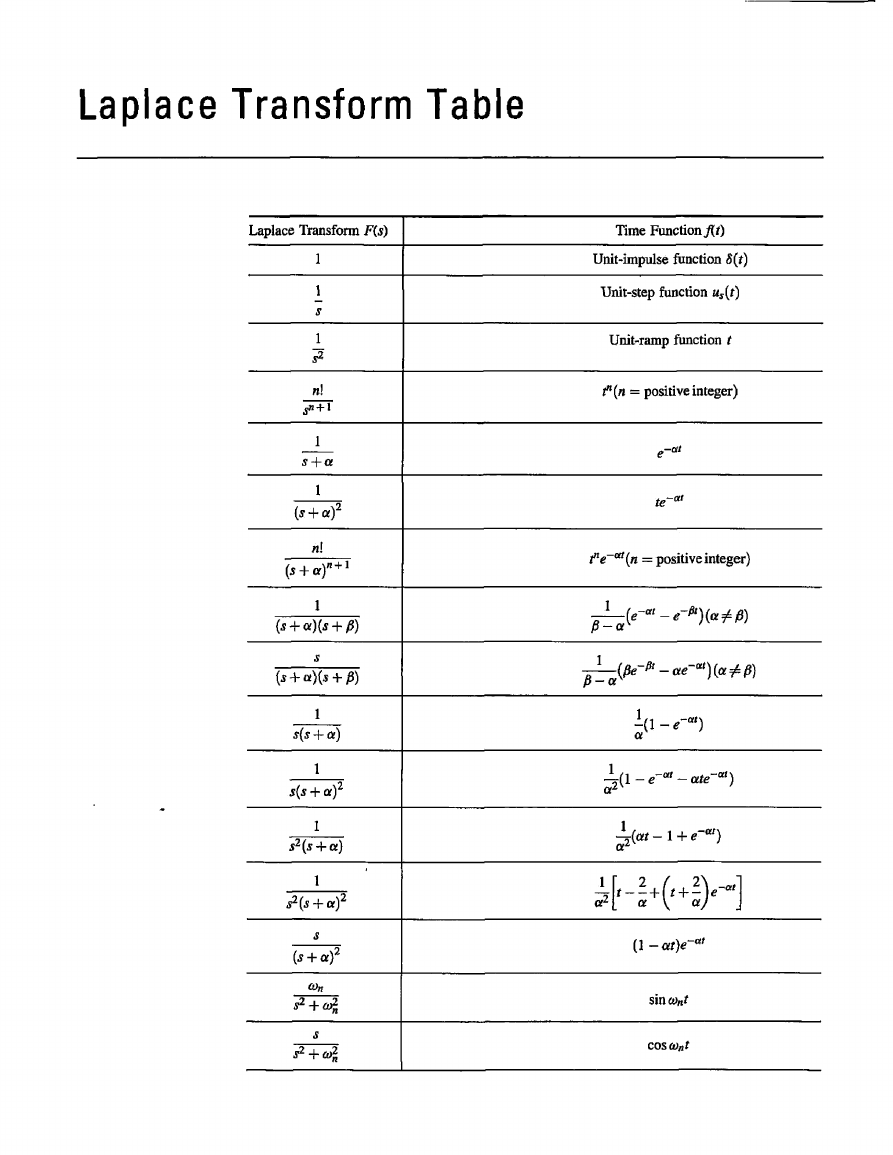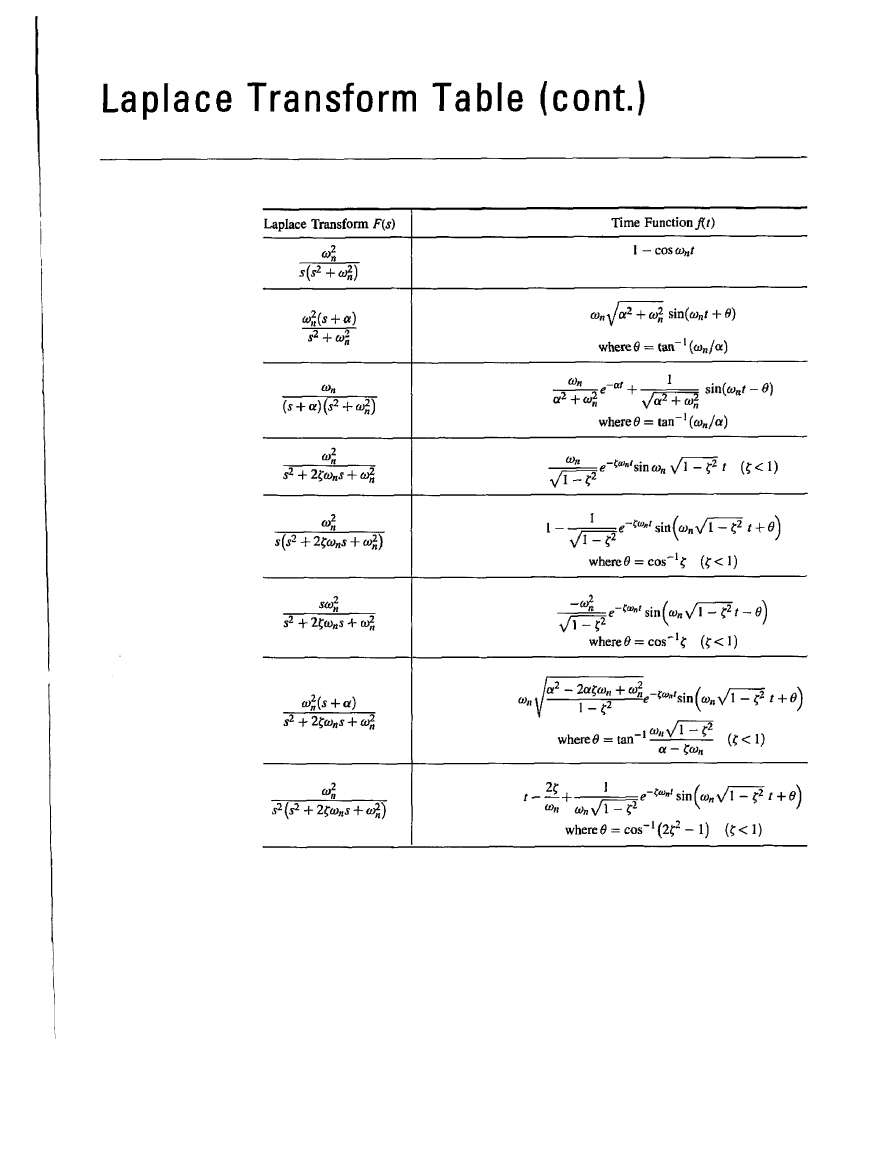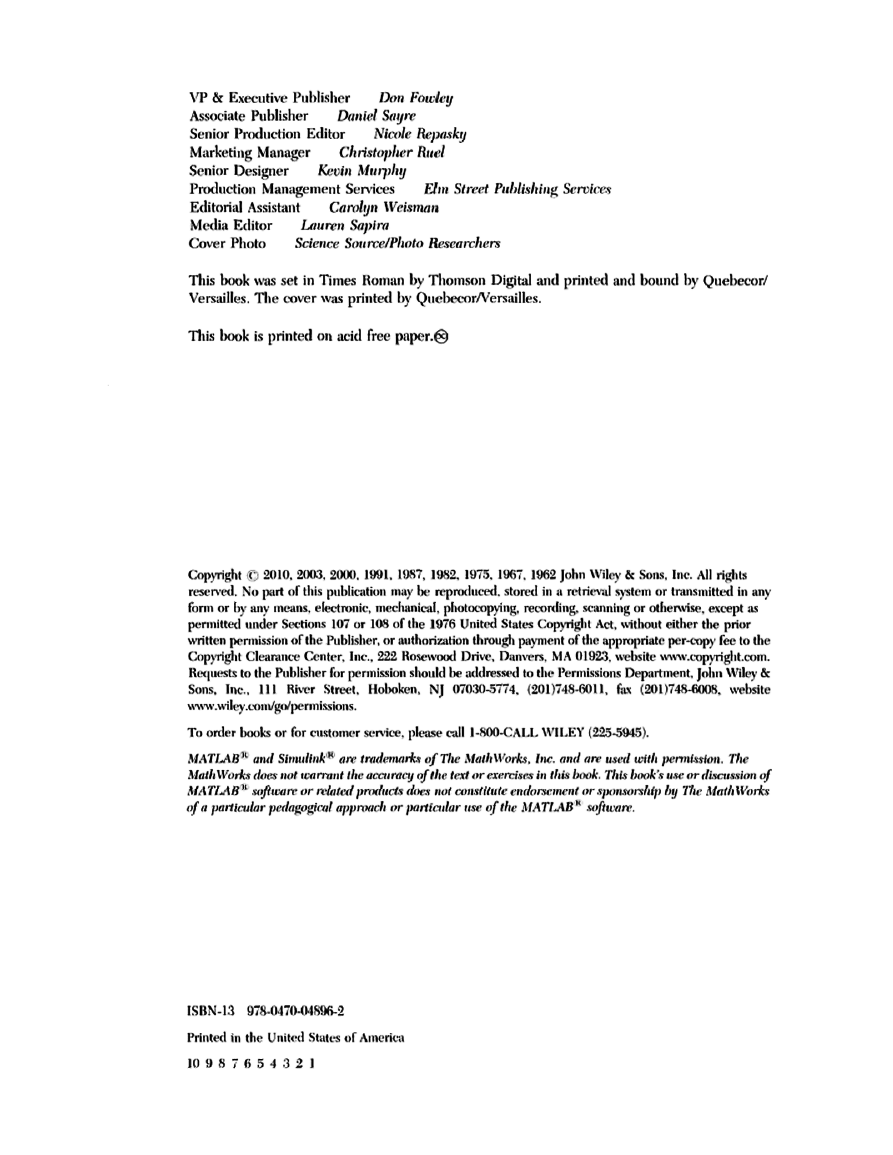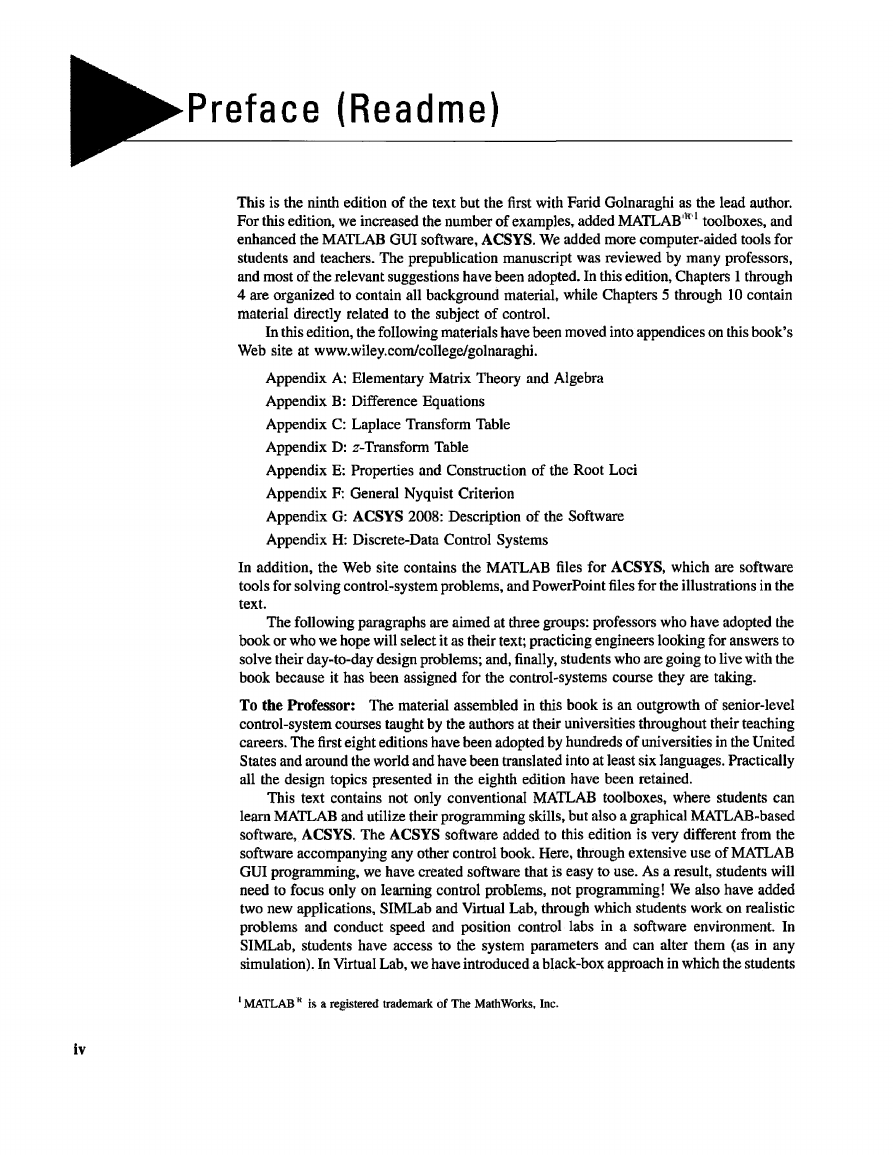Ninth Edition
Farid Golnaraghi • Benjamin C. Kuo
�
Laplace Transform Table
Laplace Transform F(s)
1
1
s
1
1
i' + Q!
1
(s + a)2
n\
(s + a)" + 1
1
(s + a)(s + p)
s
(s + a)(s + p)
1
s(s + a)
1
5(5 + a) 2
1
s2 (s + a)
1
s2(s + a)2
s
(s + a)2
CO,,
s2 + col
s
s2+co2
Time Function f(t)
Unit-impulse function 8{t)
Unit-step function Us{i)
Unit-ramp function t
f(n = positive integer)
„-«'
e
fa—at
te
t"e~°"(n = positive integer)
1
(r-M
{S-cSC
r~Pl\{n=Lt
0
C
){a*J
1
fi-o
pe-P-ae-*)^®
a
i (l - e~ at - ate'0")
or
L{ca-\
or
+ e-m)
1
a2
a
\
ct/
(1
-at)e-°"
sin co„t
I W W f ll
�
Laplace Transform Table (cont.)
Laplace Transform F(s)
4
s{s2+co2)
COn
*-**rt
(5 + a) (j2 + ^ 2)
w2
"'B
J 2 + 2t;cons + co2
•4
s{s2 + 2t;cons + co2)
2
SO),,
s2 + 2£co„s + co2
coj,{s + a)
s2 + 2$co„s + a>2
-I
s2(s2 + 2^cons + co2)
Time Function /(7)
1 — cos cont
con J a2 + OJ2 sin(6>„/ + 9)
where 6 = tan -' (con/a)
W"
r-°" 1
<* + «5
*
\/ff2 + co2
nnf/.t t A1
w h e r e # = t a n - (co„/a)
"*"
———e
„ - f a ) „ / o i n ,.
, /i
s i n a ; „ v J
v-2 »
C '
( r s \\
(G<1)
1
i
'
?-&"'<\«{„hl^f\ & t +a)
wherefl^cos"""1?
( f < l)
2
_u>»
r " t o " ' n n f a)
\ /l
f 2 f
fll
wherefl = cos~ l£
( ? < 1)
/ 2
-5
• W " " f ^ " ^ * ^ " " * ^ ^ 1 -f 2 , +")
V
'
where* - tan" 1 ^ 1
- ^
a - £con
(*<1)
O
j-
t - ^ +
«h
1
r
tony/I-^
,
.
? ' - ** sm(w„\/l - < 2 / + 0)
7
v
where# = c o s _ l ( 2 £ 2 - l)
( f < l)
�
Automatic Control
Systems
FARID GOLNARAGHI
Simon Fraser University
BENJAMIN C. KUO
University of Illinois at Urbana-Champaign
WILEY
JOHN WILEY & SONS, INC.
�
Don Fowley
Nicole Repasky
Christopher Ruel
Elm Street Publishing Services
Daniel Sayre
VP & Executive Publisher
Associate Publisher
Senior Production Editor
Marketing Manager
Senior Designer
Production Management Services
Editorial Assistant
Media Editor
Cover Photo
Kevin Murphy
Carolyn Weisman
Lauren Sapira
Science Source/Photo Researchers
This book was set in Times Roman by Thomson Digital and printed and bound by Quebecor/
Versailles. The cover was printed by Quebecor/Versailles.
This book is printed on acid free paper.@
Copyright <: 2010. 2003. 2000. 1991. 1987, 1982. 1975. 1967. 1962 John Wiley & Sons. Inc. All rights
reserved. No part of this publication may be reproduced, stored in a retrieval system or transmitted in any
form or by any means, electronic, mechanical, photocopying, recording, scanning or otherwise, except as
permitted under Sections 107 or 108 of the 1976 United States Copyright Act, without either the prior
written permission of the Publisher, or authorization through payment of the appropriate per-eopy fee to the
Copyright Clearance Center, Inc., 222 Rosewood Drive, Danvers, MA 01923. website www.copyright.com.
Requests to the Publisher for permission should be addressed to the Permissions Department. John Wile)- &
Sons. Inc.. 111 River Street. Hoboken. NJ 07030-5774. (201)748-6011, fax (201 )748-6008. website
www.wiley.com/go/perimsstons.
To order books or for customer service, please call 1-800-CALL WILEY (225-5945).
MATLAB* and Simullnk* are trademarks of The MathWorks. Inc. and are used with permission. The
MathWorks does not warrant the accuracy of the text or exercises in this hook. This book'S use or discussion of
MATIAB* software or related products does not constitute endorsement or sponsorship hy The MathWorks
of a particular pedagogical approach or particular use of the MATLAB software.
ISBN-13 978-0470-04896-2
Printed in the United States of America
10 9 8 7 6 5 4 3 2 1
�
To my wife, Mitra, and to Sophia and Carmen, the joys of my life.
—M. Farid Golnaraghi
�
Preface (Readme)
This is the ninth edition of the text but the first with Farid Golnaraghi as the lead author.
For this edition, we increased the number of examples, added MATLAB'" ' toolboxes, and
enhanced the MATLAB GUI software, ACSYS. We added more computer-aided tools for
students and teachers. The prepublication manuscript was reviewed by many professors,
and most of the relevant suggestions have been adopted. In this edition, Chapters 1 through
4 are organized to contain all background material, while Chapters 5 through 10 contain
material directly related to the subject of control.
In this edition, the following materials have been moved into appendices on this book's
Web site at www.wiley.com/college/golnaraghi.
Appendix A: Elementary Matrix Theory and Algebra
Appendix B: Difference Equations
Appendix C: Laplace Transform Table
Appendix D: z-Transform Table
Appendix E: Properties and Construction of the Root Loci
Appendix F: General Nyquist Criterion
Appendix G: ACSYS 2008: Description of the Software
Appendix H: Discrete-Data Control Systems
In addition, the Web site contains the MATLAB files for ACSYS, which are software
tools for solving control-system problems, and PowerPoint files for the illustrations in the
text.
The following paragraphs are aimed at three groups: professors who have adopted the
book or who we hope will select it as their text; practicing engineers looking for answers to
solve their day-to-day design problems; and, finally, students who are going to live with the
book because it has been assigned for the control-systems course they are taking.
To the Professor: The material assembled in this book is an outgrowth of senior-level
control-system courses taught by the authors at their universities throughout their teaching
careers. The first eight editions have been adopted by hundreds of universities in the United
States and around the world and have been translated into at least six languages. Practically
all the design topics presented in the eighth edition have been retained.
This text contains not only conventional MATLAB toolboxes, where students can
learn MATLAB and utilize their programming skills, but also a graphical MATLAB-based
software, ACSYS. The ACSYS software added to this edition is very different from the
software accompanying any other control book. Here, through extensive use of MATLAB
GUI programming, we have created software that is easy to use. As a result, students will
need to focus only on learning control problems, not programming! We also have added
two new applications, SIMLab and Virtual Lab, through which students work on realistic
problems and conduct speed and position control labs in a software environment. In
SIMLab, students have access to the system parameters and can alter them (as in any
simulation). In Virtual Lab, we have introduced a black-box approach in which the students
1 MATLAB " is a registered trademark of The Math Works. Inc.
iv
�
Preface
v
have no access to the plant parameters and have to use some sort of system identification
technique to find them. Through Virtual Lab we have essentially provided students with a
realistic online lab with all the problems they would encounter in a real speed- or position-
control lab—for example, amplifier saturation, noise, and nonlinearity. We welcome your
ideas for the future editions of this book.
Finally, a sample section-by-section for a one-semester course is given in the
Instructor's Manual, which is available from the publisher to qualified instructors. The
Manual also contains detailed solutions to all the problems in the book.
To Practicing Engineers: This book was written with the readers in mind and is very
suitable for self-study. Our objective was to treat subjects clearly and thoroughly. The book
does not use the theorem-proof-Q.E.D. style and is without heavy mathematics. The
authors have consulted extensively for wide sectors of the industry for many years and have
participated in solving numerous control-systems problems, from aerospace systems to
industrial controls, automotive controls, and control of computer peripherals. Although it is
difficult to adopt all the details and realism of practical problems in a textbook at this level,
some examples and problems reflect simplified versions of real-life systems.
To Students: You have had it now that you have signed up for this course and your
professor has assigned this book! You had no say about the choice, though you can form
and express your opinion on the book after reading it. Worse yet, one of the reasons that
your professor made the selection is because he or she intends to make you work hard. But
please don't misunderstand us: what we really mean is that, though this is an easy book to
study (in our opinion), it is a no-nonsense book. It doesn't have cartoons or nice-looking
photographs to amuse you. From here on, it is all business and hard work. You should have
had the prerequisites on subjects found in a typical linear-systems course, such as how to
solve linear ordinary differential equations, Laplace transform and applications, and time-
response and frequency-domain analysis of linear systems. In this book you will not find
too much new mathematics to which you have not been exposed before. What is interesting
and challenging is that you are going to learn how to apply some of the mathematics that
you have acquired during the past two or three years of study in college. In case you need to
review some of the mathematical foundations, you can find them in the appendices on this
book's Web site. The Web site also contains lots of other goodies, including the ACSYS
software, which is GUI software that uses MATLAB-based programs for solving linear
control systems problems. You will also find the Simulink" 12-based SIMLab and Virtual
Lab, which will help you to gain understanding of real-world control systems.
This book has numerous illustrative examples. Some of these are deliberately simple
for the purpose of illustrating new ideas and subject matter. Some examples are more
elaborate, in order to bring the practical world closer to you. Furthermore, the objective of
this book is to present a complex subject in a clear and thorough way. One of the important
learning strategies for you as a student is not to rely strictly on the textbook assigned. When
studying a certain subject, go to the library and check out a few similar texts to see how
other authors treat the same subject. You may gain new perspectives on the subject and
discover that one author may treat the material with more care and thoroughness than the
others. Do not be distracted by written-down coverage with oversimplified examples. The
minute you step into the real world, you will face the design of control systems with
nonlinearities and/or time-varying elements as well as orders that can boggle your mind. It
2 Simulink'1* is a registered trademark of The Math Works, Inc.
�
















 2023年江西萍乡中考道德与法治真题及答案.doc
2023年江西萍乡中考道德与法治真题及答案.doc 2012年重庆南川中考生物真题及答案.doc
2012年重庆南川中考生物真题及答案.doc 2013年江西师范大学地理学综合及文艺理论基础考研真题.doc
2013年江西师范大学地理学综合及文艺理论基础考研真题.doc 2020年四川甘孜小升初语文真题及答案I卷.doc
2020年四川甘孜小升初语文真题及答案I卷.doc 2020年注册岩土工程师专业基础考试真题及答案.doc
2020年注册岩土工程师专业基础考试真题及答案.doc 2023-2024学年福建省厦门市九年级上学期数学月考试题及答案.doc
2023-2024学年福建省厦门市九年级上学期数学月考试题及答案.doc 2021-2022学年辽宁省沈阳市大东区九年级上学期语文期末试题及答案.doc
2021-2022学年辽宁省沈阳市大东区九年级上学期语文期末试题及答案.doc 2022-2023学年北京东城区初三第一学期物理期末试卷及答案.doc
2022-2023学年北京东城区初三第一学期物理期末试卷及答案.doc 2018上半年江西教师资格初中地理学科知识与教学能力真题及答案.doc
2018上半年江西教师资格初中地理学科知识与教学能力真题及答案.doc 2012年河北国家公务员申论考试真题及答案-省级.doc
2012年河北国家公务员申论考试真题及答案-省级.doc 2020-2021学年江苏省扬州市江都区邵樊片九年级上学期数学第一次质量检测试题及答案.doc
2020-2021学年江苏省扬州市江都区邵樊片九年级上学期数学第一次质量检测试题及答案.doc 2022下半年黑龙江教师资格证中学综合素质真题及答案.doc
2022下半年黑龙江教师资格证中学综合素质真题及答案.doc